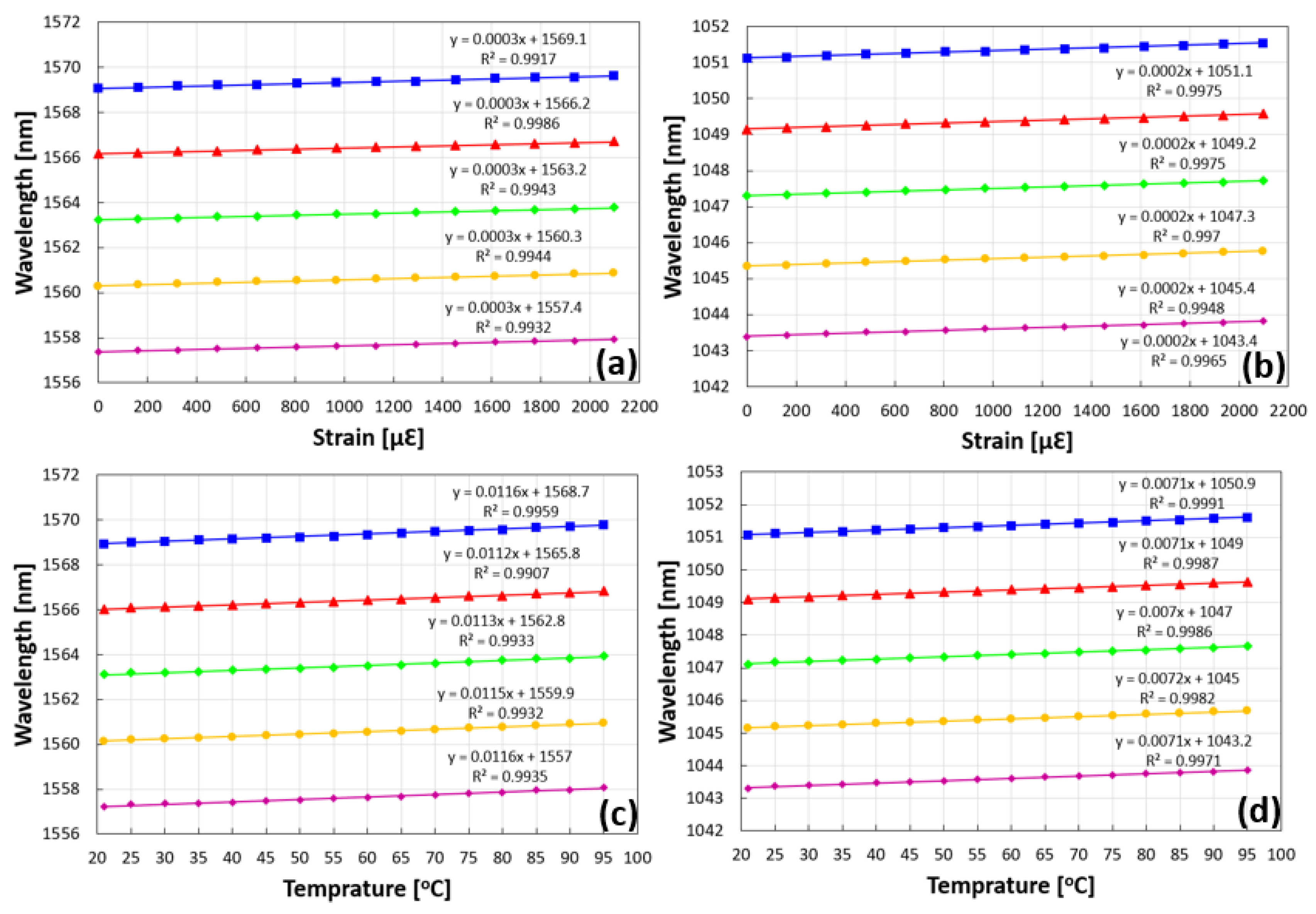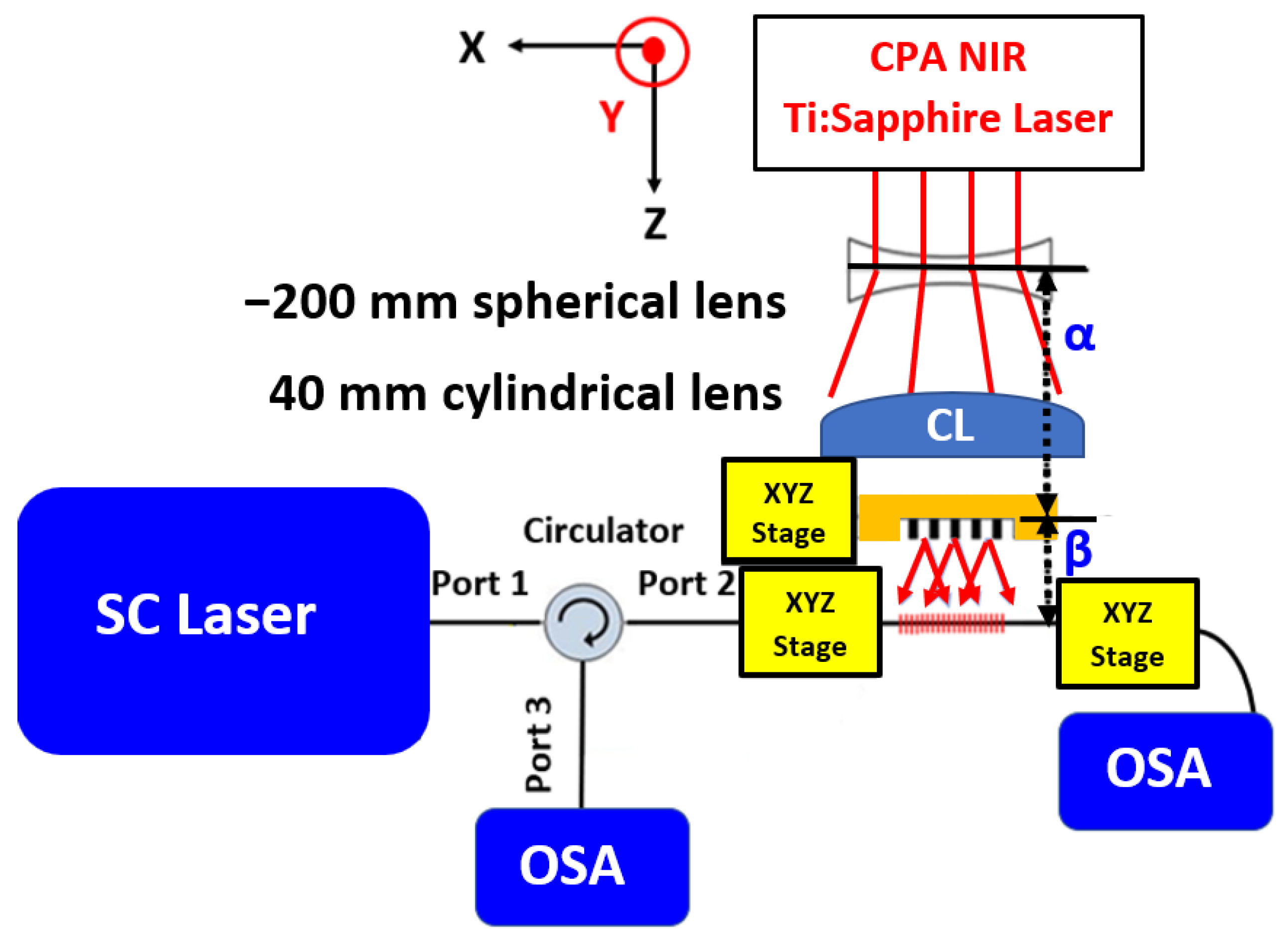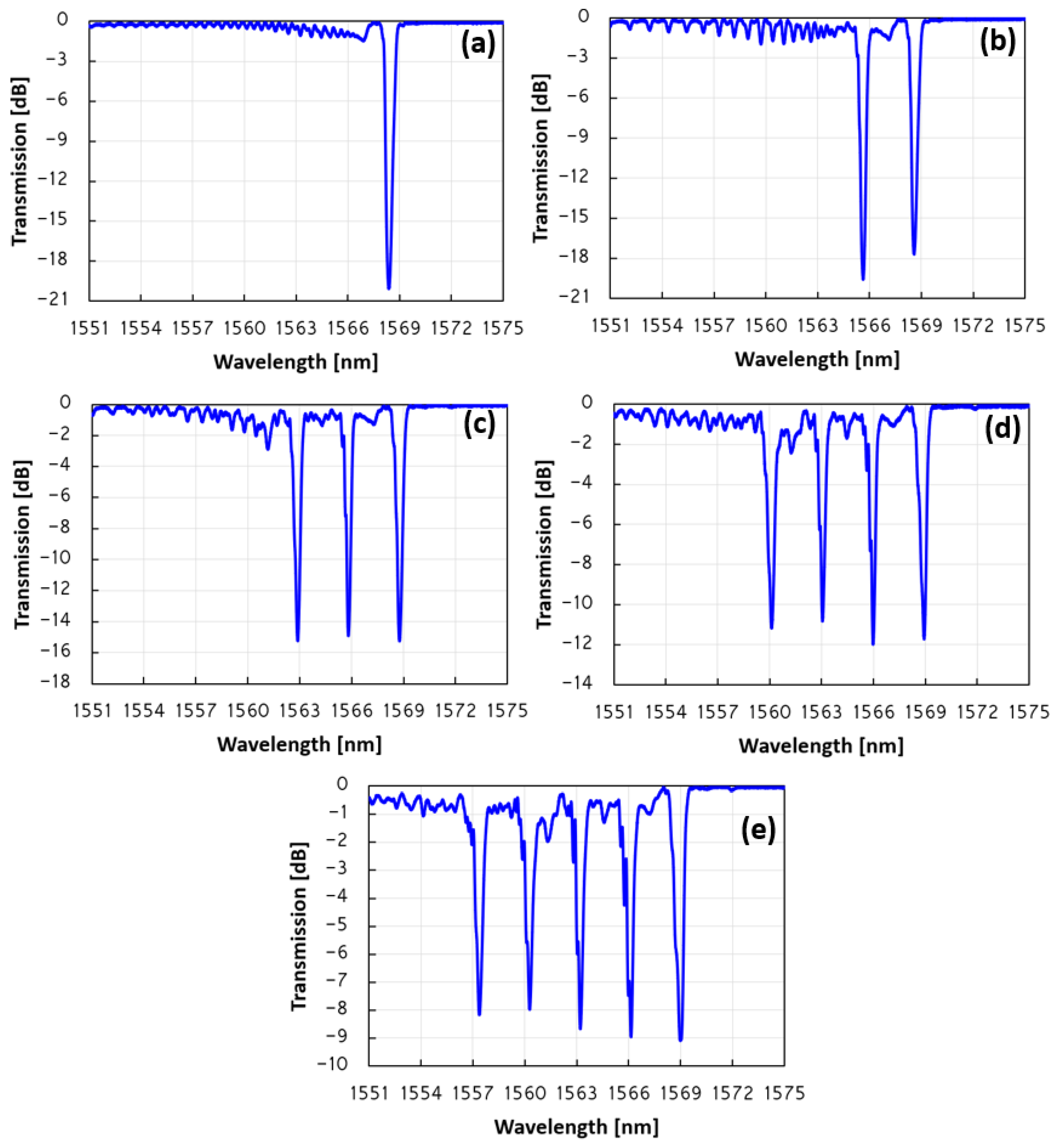Femtosecond Inscription of a Fiber Bragg Grating Spectral Array in the Same Spatial Location
Abstract
:1. Introduction
2. Experimental Setup Description
3. Femtosecond Inscription of an Array of Five FBGs
4. Strain and Temperature Sensitivity

5. Conclusions
Author Contributions
Funding
Institutional Review Board Statement
Informed Consent Statement
Data Availability Statement
Conflicts of Interest
References
- Davis, K.M.; Miura, K.; Sugimoto, N.; Hirao, K. Writing waveguides in glass with a femtosecond laser. Opt. Lett. 1996, 21, 1729–1731. [Google Scholar] [CrossRef]
- Gattass, R.R.; Mazur, E. Femtosecond laser micromachining in transparent materials. Nat. Photonics 2008, 2, 219–225. [Google Scholar] [CrossRef]
- Martinez, A.; Dubov, M.; Khrushchev, I.; Bennion, I. Direct writing of fibre Bragg gratings by femtosecond laser. Electron. Lett. 2004, 40, 1170–1172. [Google Scholar] [CrossRef]
- Zhou, K.; Dubov, M.; Mou, C.; Zhang, L.; Mezentsev, V.K.; Bennion, I. Line-by-line fiber Bragg grating made by femtosecond laser. IEEE Photonics Technol. Lett. 2010, 22, 1190–1192. [Google Scholar] [CrossRef]
- Lu, P.; Mihailov, S.J.; Ding, H.M.; Grobnic, D.; Walker, R.B. Plane-by-plane inscription of grating structures in optical fibers. J. Light. Technol. 2018, 36, 926–931. [Google Scholar] [CrossRef]
- Mihailov, S.J.; Grobnic, D.; Smelser, C.W.; Lu, P.; Walker, R.B.; Ding, H. Bragg grating inscription in various optical fibers with femtosecond infrared lasers and a phase mask. Opt. Mater. Exp. 2011, 1, 754–765. [Google Scholar] [CrossRef]
- Thomas, J.; Voigtlaender, C.; Becker, R.G.; Richter, D.; Tuennermann, A.; Nolte, S. Femtosecond pulse written fiber gratings: A new avenue to integrated fiber technology. Laser Photonics Rev. 2012, 6, 709. [Google Scholar] [CrossRef]
- Erdogan, T. Fiber Grating Spectra. J. Light. Technol. 1997, 15, 1277–1294. [Google Scholar] [CrossRef]
- Prohaska, J.D.; Snitzer, E.; Rishton, S.; Boegli, V. Magnification of mask fabricated fibre Bragg gratings. Electron. Lett. 1993, 29, 1614–1615. [Google Scholar] [CrossRef]
- Voigtlaender, C.; Becker, R.G.; Thomas, J.; Richter, D.; Singh, A.; Tuennermann, A.; Nolte, S. Ultrashort pulse inscription of tailored fiber Bragg gratings with a phase mask and a deformed wavefront [Invited]. Opt. Mater. Exp. 2011, 1, 633–642. [Google Scholar] [CrossRef]
- Halstuch, A.; Ishaaya, A.A. Femtosecond inscription of phase-shifted fiber Bragg gratings using defocusing and phase-mask movement. Opt. Fiber Technol. 2021, 67, 102689. [Google Scholar] [CrossRef]
- Poulin, J.; Kashyap, R. Novel tuneable on-fiber polymeric phase-mask for fiber and planar waveguide Bragg grating fabrication. Opt. Exp. 2005, 13, 4414–4419. [Google Scholar] [CrossRef] [PubMed]
- Voigtlaender, C.; Krämer, R.G.; Goebel, T.A.; Richter, D.; Nolte, S. Variable wavefront tuning with a SLM for tailored femtosecond fiber Bragg grating inscription. Opt. Lett. 2016, 41, 17–20. [Google Scholar] [CrossRef] [PubMed]
- Goebel, T.A.; Voigtlaender, C.; Krämer, R.G.; Richter, D.; Heck, M.; Siems, M.P.; Matzdorf, C.; Reinlein, C.; Appelfelder, M.; Schreiber, T.; et al. Flexible femtosecond inscription of fiber Bragg gratings by an optimized deformable mirror. Opt. Lett. 2017, 42, 4215–4218. [Google Scholar] [CrossRef]
- Zhang, Q.; Brown, D.; Reinhart, L.; Morse, T.; Wang, J.; Xiao, G. Tuning Bragg wavelength by writing gratings on prestrained fibers. IEEE Photon. Technol. Lett. 1994, 6, 839–841. [Google Scholar] [CrossRef]
- Halstuch, A.; Ishaaya, A.A. Strain-assisted femtosecond inscription of phase-shifted gratings. Opt. Lett. 2018, 16, 3893–3896. [Google Scholar] [CrossRef]
- Shamir, A.; Ishaaya, A. A Effect of femtosecond photo-treatment on inscription of fiber Bragg gratings. Opt. Lett. 2016, 41, 765–768. [Google Scholar] [CrossRef]
- Halstuch, A.; Ishaaya, A.A. Characterizing the effect of femtosecond photo-treatment on the center wavelength of fiber Bragg gratings. Opt. Exp. 2018, 26, 18990–18997. [Google Scholar] [CrossRef]
- Goebel, T.A.; Nold, J.; Hupel, C.; Kuhn, S.; Haarlammert, N.; Schreiber, T.; Matzdorf, C.; Imogore, T.O.; Krämer, R.G.; Richter, D.; et al. Ultrashort pulse written fiber Bragg gratings as narrowband filters in multicore fibers. Appl. Opt. 2021, 60, D43–D51. [Google Scholar] [CrossRef]
- Presti, D.L.; Massaroni, C.; Jorge, C.S.; Leitao, M.; Domingues, D.F.; Sypabekova, M.; Barrera, D.; Floris, I.; Massari, L.; Oddo, C.M.; et al. Fiber Bragg gratings for medical applications and future challenges: A review. IEEE Access 2020, 8, 156863–156888. [Google Scholar] [CrossRef]
- Riza, M.A.; Go, Y.I.; Harun, S.W.; Maier, R.R.J. FBG sensors for environmental and biochemical applications—A review. IEEE Sens. J. 2020, 20, 7614–7627. [Google Scholar] [CrossRef]
- Li, T.; Guo, J.; Tan, Y.; Zhou, Z. Recent advances and tendency in fiber Bragg grating-based vibration sensor: A review. IEEE Sens. J. 2020, 20, 12074–12087. [Google Scholar] [CrossRef]
- Campanella, C.E.; Cuccovillo, A.; Campanella, C.; Yurt, A.; Passaro, V.M.N. Fibre Bragg Grating Based Strain Sensors: Review of Technology and Applications. Sensors 2018, 18, 3115. [Google Scholar] [CrossRef]
- Della Valle, G.; Osellame, R.; Laporta, P. Micromachining of photonic devices by femtosecond laser pulses. J. Opt. A Pure Appl. Opt. 2009, 11, 013001. [Google Scholar] [CrossRef]
- Shamir, A.; Ishaaya, A.A. Femtosecond inscription of phase-shifted gratings by overlaid fiber Bragg gratings. Opt. Lett. 2016, 41, 2017–2020. [Google Scholar] [CrossRef]
- Krämer, R.G.; Fischer, B.; Matzdorf, C.; Goebel, T.A.; Richter, D.; Morandotti, R.; Nolte, S. High contrast ultrashort pulse written transmission filter based on Moiré fiber grating. In Frontiers in Ultrafast Optics: Biomedical, Scientific, and Industrial Applications XX; SPIN: Bellingham, WA, USA, 2020; Volume 11270, pp. 61–67. [Google Scholar]
- Kashyap, R. Fiber Bragg Gratings, 2nd ed.; Academic Press: Waltham, MA, USA, 2009. [Google Scholar]
- Smelser, C.W.; Grobnic, D.; Mihailov, S.J. Generation of pure two-beam interference grating structures in an optical fiber with a femtosecond infrared source and a phase mask. Opt. Lett. 2004, 29, 1730–1732. [Google Scholar] [CrossRef]
- Halstuch, A.; Ishaaya, A.A. Femtosecond inscription of chirped fiber Bragg gratings and fiber Bragg grating arrays using a single uniform phase-mask. Opt. Lasers Eng. 2023, 160, 107286. [Google Scholar] [CrossRef]




Disclaimer/Publisher’s Note: The statements, opinions and data contained in all publications are solely those of the individual author(s) and contributor(s) and not of MDPI and/or the editor(s). MDPI and/or the editor(s) disclaim responsibility for any injury to people or property resulting from any ideas, methods, instructions or products referred to in the content. |
© 2023 by the authors. Licensee MDPI, Basel, Switzerland. This article is an open access article distributed under the terms and conditions of the Creative Commons Attribution (CC BY) license (https://creativecommons.org/licenses/by/4.0/).
Share and Cite
Halstuch, A.; Ishaaya, A.A. Femtosecond Inscription of a Fiber Bragg Grating Spectral Array in the Same Spatial Location. Sensors 2023, 23, 4064. https://doi.org/10.3390/s23084064
Halstuch A, Ishaaya AA. Femtosecond Inscription of a Fiber Bragg Grating Spectral Array in the Same Spatial Location. Sensors. 2023; 23(8):4064. https://doi.org/10.3390/s23084064
Chicago/Turabian StyleHalstuch, Aviran, and Amiel A. Ishaaya. 2023. "Femtosecond Inscription of a Fiber Bragg Grating Spectral Array in the Same Spatial Location" Sensors 23, no. 8: 4064. https://doi.org/10.3390/s23084064





